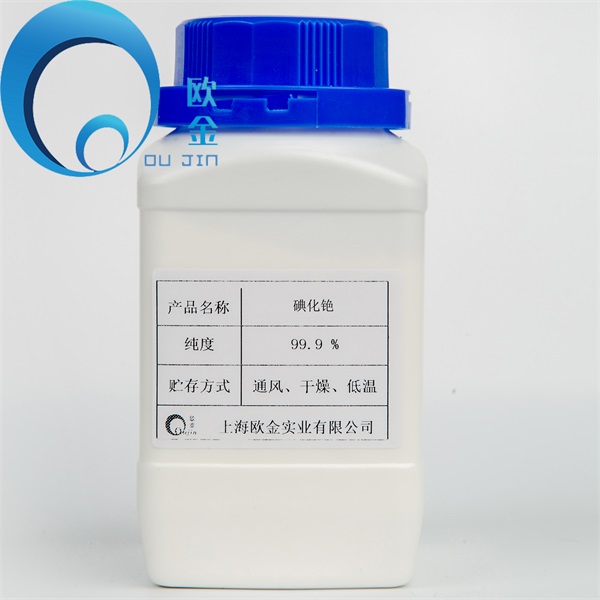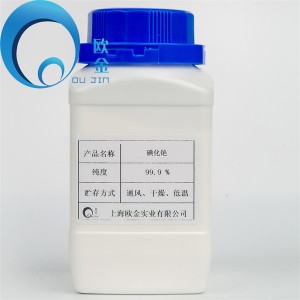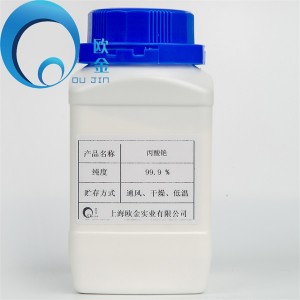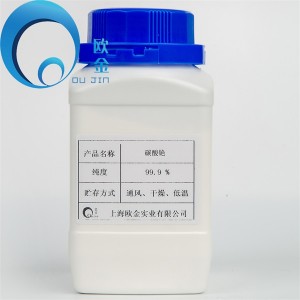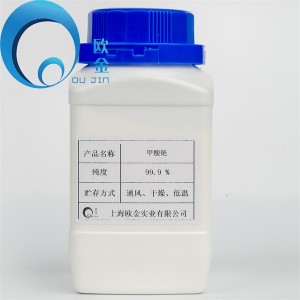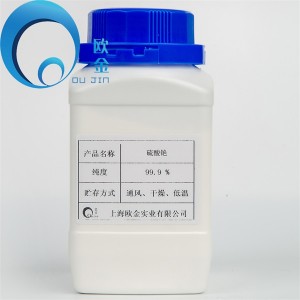
Products
Cesium Iodide
The chemical formula of cesium hydroxide CsOH. Molecular weight 149.916. White crystalline solid, easily deliriable. Density 3.675 g/mL, melting point 272.3℃. Soluble in water, aqueous solution has strong alkalinity. Both solid and solution can absorb carbon dioxide from the air [1]. It is highly corrosive and should be used with care. It should be placed in a tight storage container, kept sealed and stored in a cool, dry place.
Physical properties
It is hygroscopic and soluble in water. The saturated solution at 30℃ contains Cs2O at 70.63% and soluble in ethanol. Azide, chromate and iodide can be prepared from hydroxide.
Chemical properties
The hot concentrated solution reacts quickly with nickel or silver.
Heat the solution to 180 ° C in a platinum container and dehydrated to form a hydrate. Further heating to 400 ° C could further dehydrate anhydrous matter.
Cesium formate, cesium oxalate and cesium carbonate are formed by reacting with carbon monoxide at high temperature.
If used and stored according to specifications, it will not decompose.
Can corrode glass. Cesium hydroxide, like other alkali hydroxides, is a strong alkaline and is delirious. Cesium hydroxide monohydrate is commonly used in laboratory. Avoid acidic mixing.
Response characteristics
Stability: Stability to be avoided: stability at room temperature, but exposure to air will absorb moisture and carbon dioxide
Aggregation of hazards: does not occur
Incompatibility: Substances to be avoided:
1. Amphoteric metals (e.g. aluminium, tin, zinc, etc.) : react to produce hydrogen.
2. Acid and acid oxide: cause reaction.
3. Water: Dissolving releases a lot of heat.
4. Carbon dioxide: Reaction deterioration.
Fire extinguishing material
1. Chemical dry powder
2. Carbon dioxide
Special extinguishing procedure
1. Cesium hydroxide is non-combustible, and the extinguishing agent used shall be suitable for extinguishing peripheral substances.
2. The melting temperature of the substance is high, if the hot or molten material contact with water, it will cause a violent reaction, and will ignite the combustible material.
3. It also reacts with various metals (e.g., lead, zinc, etc.) to produce hydrogen.
4. Be careful not to splash this material when extinguishing the fire, as it will release a lot of heat when dissolved in water.
5. Remove container from fire with security clearance.
6. Fire fighting personnel should take personal protection first.
The preparation methods
It can be prepared by hydrolysis of cesium amalgam or reaction of cesium sulfate with barium hydroxide.
Application field
A strong alkaline is used as a catalyst in the polymerization reaction and electrolyte of the battery.
Toxicological data
Acute toxicity: oral LD50:570mg/kg; Rats LD50:800mg/kg [2] [4]
Ecological data
It is a serious hazard to water. Do not drain materials into the surrounding environment without permission of the government.
preventive measure
Personal protective equipment
Eyes: Dustproof goggles and face mask when handling this chemical (splash proof chemical goggles are used when using solution)
Breathing:
1. Improper use of respiratory protective equipment is dangerous; When using dust filter material, it is necessary to check whether there is any physical damage such as breakage.
2. Use a respirator with dust filter, or even a power-type comprehensive respirator for air purification.
Gloves: PVC anti-seepage gloves, alkali resistant gloves.
Others: protective clothing made of the above materials, protective boots and shoes
Ventilation equipment
1. Use closed operation whenever possible.
2. Use a local exhaust device where the substance has been released.
Precautions for operation and storage
1. Do not coexist with strong acids (such as hydrochloric acid, sulfuric acid and nitric acid), and do not store in glass containers, which will corrode the glass.
2. Store in a tight container in a cool, well-ventilated place.
3. Reuse and dispose. Do not store any ignition sources such as smoking or open flame.
4. Operate in chemical fume hoods only.
Personal hygiene
1. Remove contaminated clothing as soon as possible after work and wash them before they can be worn or discarded, and inform the laundry personnel of the dangers of the pollutants.
Smoking or eating is strictly prohibited in the workplace.
Wash hands thoroughly after handling the object.
4. Keep the workplace clean and tidy.
Disposal processing
Emergency response to a leak
1. Restrict access to the contaminated area until it is completely cleared.
2. Remove all ignition sources.
3. Liquid condition: Use fire extinguishers, soil, sand or similar substances to absorb the liquid can be diluted with water or carefully neutralized with dilute acid solution. And dispose of in an airtight container.
4. Solid condition: if safety permits, quickly pick up the material with a shovel and place it in an airtight container to avoid dust generation. (Do not shovel the substance yourself without permission.)
5. Clean up the leaking material as quickly as possible, because it is more difficult to clean up after the material is hygroscopic.
6. After thorough cleaning, ventilate the area and dilute it with plenty of water.
7. Inform safety, health and environmental protection related units and manufacturers immediately in case of large leakage and fire.
8. Avoid leakage into sewers, gutters or confined Spaces. Only allow discharge.

